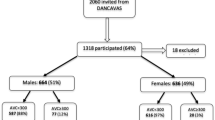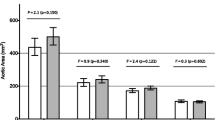Abstract
Aortic distensibility (AD) decreases with age and increased aortic stiffness is independently associated with adverse cardiovascular outcomes. The association of severe aortic stenosis (AS) with AD in different aortic regions has not been evaluated. Elderly subjects with severe AS and a cohort of patients without AS of similar age were studied. Proximal aortic cross-sectional-area changes during the cardiac cycle were determined using retrospective-ECG-gating on 128-detector row computed-tomography. Using oscillometric-brachial-blood-pressure measurements, the AD at the ascending-aorta (AA), proximal-descending-aorta (PDA) and distal-descending-aorta (DDA) was determined. Linear mixed effects modelling was used to determine the association of age and aortic stenosis on regional AD. 102 patients were evaluated: 36 AS patients (70–85 years), 24 AS patients (>85 years) and 42 patients without AS (9 patients <50 years, 20 patients between 51–70 years and 13 patients 70–85 years). When comparing patients 70–85 years, AA distensibility was significantly lower in those with AS compared to those without AS (0.9 ± 0.9 vs. 1.4 ± 1.1, P = 0.03) while there was no difference in the PDA (1.0 ± 1.1 vs. 1.0 ± 1.2, P = 0.26) and DDA (1.1 ± 1.2 vs. 1.2 ± 0.8, P = 0.97). In patients without AS, AD decreased with age in all aortic regions (P < 0.001). The AA in patients <50 years were the most distensible compared to other aortic regions. There is regional variation in aortic distensibility with aging. Patients with aortic stenosis demonstrated regional differences in aortic distensibility with lower distensibility demonstrated in the proximal ascending aorta compared to an age-matched cohort.



Similar content being viewed by others
References
Nelson AJ, Worthley SG, Cameron JD, Willoughby SR, Piantadosi C, Carbone A, Dundon BK, Leung MC, Hope SA, Meredith IT, Worthley MI (2009) Cardiovascular magnetic resonance-derived aortic distensibility: validation and observed regional differences in the elderly. J Hypertens 27(3):535–542
Ganten M, Krautter U, Hosch W, Hansmann J, von Tengg-Kobligk H, Delorme S, Kauczor HU, Kauffmann GW, Bock M (2007) Age related changes of human aortic distensibility: evaluation with ECG-gated CT. Eur Radiol 17(3):701–708. doi:10.1007/s00330-006-0309-z
Metafratzi ZM, Efremidis SC, Skopelitou AS, De Roos A (2002) The clinical significance of aortic compliance and its assessment with magnetic resonance imaging. J Cardiovasc Magn Reson 4(4):481–491
Siegel E, Thai WE, Techasith T, Major G, Szymonifka J, Tawakol A, Nagurney JT, Hoffmann U, Truong QA (2012) Aortic distensibility and its relationship to coronary and thoracic atherosclerosis plaque and morphology by MDCT: insights from the ROMICAT Trial. Int J Cardiol. doi:10.1016/j.ijcard.2012.04.107
Nemes A, Forster T, Csanady M (2004) Decreased aortic distensibility and coronary flow velocity reserve in patients with significant aortic valve stenosis with normal epicardial coronary arteries. J Heart Valve Dis 13(4):567–573
Laurent S, Katsahian S, Fassot C, Tropeano AI, Gautier I, Laloux B, Boutouyrie P (2003) Aortic stiffness is an independent predictor of fatal stroke in essential hypertension. Stroke 34(5):1203–1206. doi:10.1161/01.STR.0000065428.03209.64
Herrington DM, Kesler K, Reiber JC, Davis W, Brown WV, Helms R, Mallon SM, Raines J (2003) Arterial compliance adds to conventional risk factors for prediction of angiographic coronary artery disease. Am Heart J 146(4):662–667. doi:10.1016/S0002-8703(03)00254-0
Blacher J, Safar ME, Guerin AP, Pannier B, Marchais SJ, London GM (2003) Aortic pulse wave velocity index and mortality in end-stage renal disease. Kidney Int 63(5):1852–1860. doi:10.1046/j.1523-1755.2003.00932.x
Laurent S, Cockcroft J, Van Bortel L, Boutouyrie P, Giannattasio C, Hayoz D, Pannier B, Vlachopoulos C, Wilkinson I, Struijker-Boudier H (2006) Expert consensus document on arterial stiffness: methodological issues and clinical applications. Eur Heart J 27(21):2588–2605. doi:10.1093/eurheartj/ehl254
Nemes A, Galema TW, Geleijnse ML, Soliman OI, Yap SC, Anwar AM, ten Cate FJ (2007) Aortic valve replacement for aortic stenosis is associated with improved aortic distensibility at long-term follow-up. Am Heart J 153(1):147–151. doi:10.1016/j.ahj.2006.08.025
Carrascosa P, Capunay C, Deviggiano A, Rodriguez-Granillo GA, Sagarduy MI, Cortines P, Carrascosa J, Parodi JC (2013) Thoracic aorta cardiac-cycle related dynamic changes assessed with a 256-slice CT scanner. Cardiovasc Diagn Ther 3(3):125–128. doi:10.3978/j.issn.2223-3652.2013.07.02
Leung MC, Meredith IT, Cameron JD (2006) Aortic stiffness affects the coronary blood flow response to percutaneous coronary intervention. Am J Physiol Heart Circ Physiol 290(2):H624–H630. doi:10.1152/ajpheart.00380.2005
Smith CR, Leon MB, Mack MJ, Miller DC, Moses JW, Svensson LG, Tuzcu EM, Webb JG, Fontana GP, Makkar RR, Williams M, Dewey T, Kapadia S, Babaliaros V, Thourani VH, Corso P, Pichard AD, Bavaria JE, Herrmann HC, Akin JJ, Anderson WN, Wang D, Pocock SJ, Investigators PT (2011) Transcatheter versus surgical aortic-valve replacement in high-risk patients. N Engl J Med 364(23):2187–2198. doi:10.1056/NEJMoa1103510
Roccabianca S, Figueroa CA, Tellides G, Humphrey JD (2014) Quantification of regional differences in aortic stiffness in the aging human. J Mech Behav Biomed Mater 29:618–634. doi:10.1016/j.jmbbm.2013.01.026
Redheuil A, Yu WC, Mousseaux E, Harouni AA, Kachenoura N, Wu CO, Bluemke D, Lima JA (2011) Age-related changes in aortic arch geometry: relationship with proximal aortic function and left ventricular mass and remodeling. J Am Coll Cardiol 58(12):1262–1270. doi:10.1016/j.jacc.2011.06.012
Bensalah MZ, Bollache E, Kachenoura N, Giron A, De Cesare A, Macron L, Lefort M, Redheuil A, Mousseaux E (2014) Geometry is a major determinant of flow reversal in proximal aorta. Am J Physiol Heart Circ Physiol 306(10):H1408–H1416. doi:10.1152/ajpheart.00647.2013
Pibarot P, Dumesnil JG (2012) Improving assessment of aortic stenosis. J Am Coll Cardiol 60(3):169–180. doi:10.1016/j.jacc.2011.11.078
Briand M, Dumesnil JG, Kadem L, Tongue AG, Rieu R, Garcia D, Pibarot P (2005) Reduced systemic arterial compliance impacts significantly on left ventricular afterload and function in aortic stenosis: implications for diagnosis and treatment. J Am Coll Cardiol 46(2):291–298. doi:10.1016/j.jacc.2004.10.081
Halloran BG, Davis VA, McManus BM, Lynch TG, Baxter BT (1995) Localization of aortic disease is associated with intrinsic differences in aortic structure. J Surg Res 59(1):17–22. doi:10.1006/jsre.1995.1126
Tsamis A, Krawiec JT, Vorp DA (2013) Elastin and collagen fibre microstructure of the human aorta in ageing and disease: a review. J R Soc Interface 10(83):20121004. doi:10.1098/rsif.2012.1004
Chatzizisis YS, Coskun AU, Jonas M, Edelman ER, Feldman CL, Stone PH (2007) Role of endothelial shear stress in the natural history of coronary atherosclerosis and vascular remodeling: molecular, cellular, and vascular behavior. J Am Coll Cardiol 49(25):2379–2393. doi:10.1016/j.jacc.2007.02.059
Davies PF (2009) Hemodynamic shear stress and the endothelium in cardiovascular pathophysiology. Nat Clin Pract Cardiovasc Med 6(1):16–26. doi:10.1038/ncpcardio1397
Siegel E, Thai WE, Techasith T, Major G, Szymonifka J, Tawakol A, Nagurney JT, Hoffmann U, Truong QA (2013) Aortic distensibility and its relationship to coronary and thoracic atherosclerosis plaque and morphology by MDCT: insights from the ROMICAT Trial. Int J Cardiol 167(4):1616–1621. doi:10.1016/j.ijcard.2012.04.107
Kingwell BA, Gatzka CD (2002) Arterial stiffness and prediction of cardiovascular risk. J Hypertens 20(12):2337–2340
Rerkpattanapipat P, Hundley WG, Link KM, Brubaker PH, Hamilton CA, Darty SN, Morgan TM, Kitzman DW (2002) Relation of aortic distensibility determined by magnetic resonance imaging in patients > or =60 years of age to systolic heart failure and exercise capacity. Am J Cardiol 90(11):1221–1225
Lehmann ED, Hopkins KD, Jones RL, Rudd AG, Gosling RG (1995) Aortic distensibility in patients with cerebrovascular disease. Clin Sci (Lond) 89(3):247–253
Dart AM, Reid CM, McGrath B, Tonometry Study G (2001) Effects of ACE inhibitor therapy on derived central arterial waveforms in hypertension. Am J Hypertens 14(8 Pt 1):804–810
Borow KM, Newburger JW (1982) Noninvasive estimation of central aortic pressure using the oscillometric method for analyzing systemic artery pulsatile blood flow: comparative study of indirect systolic, diastolic, and mean brachial artery pressure with simultaneous direct ascending aortic pressure measurements. Am Heart J 103(5):879–886
Conflict of interest
None.
Author information
Authors and Affiliations
Corresponding author
Rights and permissions
About this article
Cite this article
Wong, D.T.L., Narayan, O., Leong, D.P. et al. Regional aortic distensibility and its relationship with age and aortic stenosis: a computed tomography study. Int J Cardiovasc Imaging 31, 1053–1062 (2015). https://doi.org/10.1007/s10554-015-0640-z
Received:
Accepted:
Published:
Issue Date:
DOI: https://doi.org/10.1007/s10554-015-0640-z




